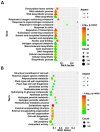Transcriptome Analysis Reveals Genes of Flooding-Tolerant and Flooding-Sensitive Rapeseeds Differentially Respond to Flooding at the Germination Stage
- PMID: 33916802
- PMCID: PMC8065761
- DOI: 10.3390/plants10040693
Transcriptome Analysis Reveals Genes of Flooding-Tolerant and Flooding-Sensitive Rapeseeds Differentially Respond to Flooding at the Germination Stage
Abstract
Flooding results in significant crop yield losses due to exposure of plants to hypoxic stress. Various studies have reported the effect of flooding stress at seedling establishment or later stages. However, the molecular mechanism prevailing at the germination stage under flooding stress remains enigmatic. The present study highlights the comparative transcriptome analysis in two rapeseed lines, i.e., flooding-tolerant (Santana) and -sensitive (23651) lines under control and 6-h flooding treatments at the germination stage. A total of 1840 up-regulated and 1301 down-regulated genes were shared by both lines in response to flooding. There were 4410 differentially expressed genes (DEGs) with increased expression and 4271 DEGs with reduced expression shared in both control and flooding conditions. Gene ontology (GO) enrichment analysis revealed that "transcription regulation", "structural constituent of cell wall", "reactive oxygen species metabolic", "peroxidase", oxidoreductase", and "antioxidant activity" were the common processes in rapeseed flooding response. In addition, the processes such as "hormone-mediated signaling pathway", "response to organic substance response", "motor activity", and "microtubule-based process" are likely to confer rapeseed flooding resistance. Mclust analysis clustered DEGs into nine modules; genes in each module shared similar expression patterns and many of these genes overlapped with the top 20 DEGs in some groups. This work provides a comprehensive insight into gene responses and the regulatory network in rapeseed flooding stress and provides guidelines for probing the underlying molecular mechanisms in flooding resistance.
Keywords: DEG; flooding stress; germination; rapeseed; transcriptome analysis.
Conflict of interest statement
The authors declare no conflict of interest.
Figures






Similar articles
-
Transcriptome analysis reveals gene responses to herbicide, tribenuron methyl, in Brassica napus L. during seed germination.BMC Genomics. 2021 Apr 23;22(1):299. doi: 10.1186/s12864-021-07614-1. BMC Genomics. 2021. PMID: 33892633 Free PMC article.
-
Transcriptome analysis and differential gene expression profiling of two contrasting quinoa genotypes in response to salt stress.BMC Plant Biol. 2020 Dec 30;20(1):568. doi: 10.1186/s12870-020-02753-1. BMC Plant Biol. 2020. PMID: 33380327 Free PMC article.
-
Associating transcriptional regulation for rapid germination of rapeseed (Brassica napus L.) under low temperature stress through weighted gene co-expression network analysis.Sci Rep. 2019 Jan 11;9(1):55. doi: 10.1038/s41598-018-37099-0. Sci Rep. 2019. PMID: 30635606 Free PMC article.
-
The Molecular Regulatory Pathways and Metabolic Adaptation in the Seed Germination and Early Seedling Growth of Rice in Response to Low O2 Stress.Plants (Basel). 2020 Oct 14;9(10):1363. doi: 10.3390/plants9101363. Plants (Basel). 2020. PMID: 33066550 Free PMC article. Review.
-
Comprehensive analysis of response and tolerant mechanisms in early-stage soybean at initial-flooding stress.J Proteomics. 2017 Oct 3;169:225-232. doi: 10.1016/j.jprot.2017.01.014. Epub 2017 Jan 28. J Proteomics. 2017. PMID: 28137666 Review.
Cited by
-
Transcriptional Response of Two Brassica napus Cultivars to Short-Term Hypoxia in the Root Zone.Front Plant Sci. 2022 Apr 29;13:897673. doi: 10.3389/fpls.2022.897673. eCollection 2022. Front Plant Sci. 2022. PMID: 35574097 Free PMC article.
-
Transcriptome and Small-RNA Sequencing Reveals the Response Mechanism of Brassica napus to Waterlogging Stress.Plants (Basel). 2025 Apr 29;14(9):1340. doi: 10.3390/plants14091340. Plants (Basel). 2025. PMID: 40364369 Free PMC article.
-
Transcriptomic analysis reveals the regulatory mechanisms of messenger RNA (mRNA) and long non-coding RNA (lncRNA) in response to waterlogging stress in rye (Secale cereale L.).BMC Plant Biol. 2024 Jun 12;24(1):534. doi: 10.1186/s12870-024-05234-x. BMC Plant Biol. 2024. PMID: 38862913 Free PMC article.
-
The roles of cell wall polysaccharides in response to waterlogging stress in Brassica napus L. root.BMC Biol. 2024 Sep 2;22(1):191. doi: 10.1186/s12915-024-01972-4. BMC Biol. 2024. PMID: 39218874 Free PMC article.
References
-
- Mendiondo G.M., Gibbs D.J., Szurman-Zubrzycka M., Korn A., Marquez J., Szarejko I., Maluszynski M., King J., Axcell B., Smart K., et al. Enhanced waterlogging tolerance in barley by manipulation of expression of the N-end rule pathway E3 ligase PROTEOLYSIS6. Plant Biotechnol. J. 2016;14:40–50. doi: 10.1111/pbi.12334. - DOI - PMC - PubMed
-
- Zhao N., Li C., Yan Y., Cao W., Song A., Wang H., Chen S., Jiang J., Chen F. Comparative Transcriptome Analysis of Waterlogging-Sensitive and Waterlogging-Tolerant Chrysanthemum morifolium Cultivars under Waterlogging Stress and Reoxygenation Conditions. Int. J. Mol. Sci. 2018;19:1455. doi: 10.3390/ijms19051455. - DOI - PMC - PubMed
LinkOut - more resources
Full Text Sources
Other Literature Sources

